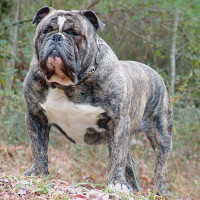The most decisive part of the breed is that it should be as large in girth as possible (girth should equal height; larger Bulls will have a larger head circumference than height). Females should not have as large a head circumference as males. Cheeks should be well defined, showing power, cheek definition to be taken into account at Bulldogge age (this characteristic gains definition with age), 2 to 3 years final maturity. Too much attention should not be placed on this feature in a young Bulldogge. The jaws should be as follows : lower jaw protruding further than the upper jaw, giving the jaw an upward turn. The bite should be square. Teeth : Canines should be set wide apart, with smaller teeth between them. Lips should be loose and heavy (but not sloppy), hanging below the jaw and full in appearance. The nose should lie well, broad and moist, perfectly black preferred, partially colored or Dudley noses are not preferred but are not a disqualification. Eyes as far apart as possible, large without bulging. Eyes should be perfectly placed (equal on each side) from the middle of the skull. Ears should be rose-shaped (short, small and folded more to the side) or button-shaped (semi-pierced with forward fold). The stop is the indentation between the eyes. The stop should be deep and wide, extending to the skull, giving the skull a square appearance. The depth of the stop gives more definition to how the eyes and ears are set. Thick, strong and arched, with loose skin forming the dewlap on each side, the neck should be short, not having a long aspect at all. Bulldogs should have what we call a bull neck (thick, muscular and short), not a swan neck (too long or little muscle), which would show no strength or shape. Shoulders should be broad and deep. Chest should be well suspended and deep. A rise to the rear is desirable as long as it is not excessive, which would cause the dog's symmetry to suffer.
The forelegs should be muscular, straight and wide apart, a slight bow is not a fault unless it is in excess with the elbows turned outwards. The Bulldogge should stand on its pasterns, which should be strong. The hind legs should be muscular and show power, hocks slightly bent, feet round and compact. The chest is as broad and deep as possible, with a ribcage in proportion. Ribs should be round. Loins should be powerful with tuck-up that does not suppress the cobby appearance. Either straight, turning or screwed. The tail must not be carried over the back. There is no deduction for a docked tail, as it has no effect on the dog's quality. The hind legs must be higher than the front legs without exaggeration, they must show at the level of the stifle (knee) without excess so that the hock turns slightly inwards, the paws are longer than the front paws and are compact. The forelegs are shorter than the hind legs. The front legs must be powerful and can be straight or curved (but not excessively so). The front legs should be turned slightly at the shoulder so that the body can swing. Should be direct to pastern, feet should be large, moderately round. Toes should be separated but not spread. There is no deduction for tight toes. Colors available : brindle/white, all other brindle (including black/brindle), solid white or pied, fawn or beige. Solid black is an undesirable color. Blue is not an original Bulldogge color, but is permitted. When judged, color should not play a factor in the quality of the dog, the color of the bulldogge should not be considered except in cases of equal merit. Undesirables would then be taken second. The coat is short and close, very smooth and silky to the touch. Males measure between 46 and 50 centimeters, weighing between 29 and 45 kilos, while females measure between 44 and 48 centimeters, weighing between 25 and 38 kilos. |
| The Olde Victorian Bulldogge is a loyal, well-tempered and stable dog. It gets on well with other family pets when raised with them, and loves children. He is courageous and protective. He saves his deep bark for really important matters. He is big and strong. If he feels his owners are not as strong-minded as himself, he can become stubborn, so strong leadership is advised. As puppies, they'll chew anything they can get their hands on. The Bulldogge should be stable, loyal and true with a reliable nature. He should be bold without aggression. The aim of training this dog is to achieve pack leader status. It's a natural instinct for a dog to have an order in his pack. When we humans live with dogs, we become their pack. The whole pack cooperates under one leader. Lines are clearly drawn and rules are defined. Because a dog communicates his displeasure by growling and finally biting, all other humans MUST be higher in the pecking order than the dog. Humans must be the ones making the decisions, not the dogs. This is the only way your relationship with your dog can be a complete success. |







 English (United Kingdom)
English (United Kingdom)